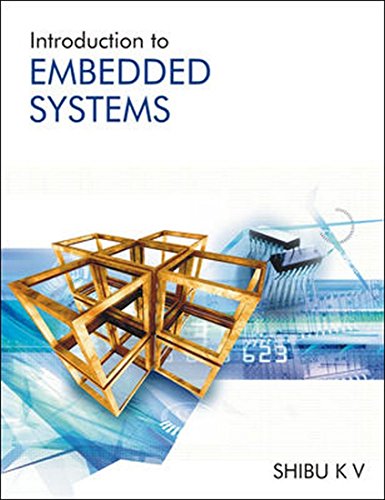

Most ebook files are in PDF format, so you can easily read them using various software such as Foxit Reader or directly on the Google Chrome browser.
Some ebook files are released by publishers in other formats such as .awz, .mobi, .epub, .fb2, etc. You may need to install specific software to read these formats on mobile/PC, such as Calibre.
Please read the tutorial at this link. https://ebooknice.com/page/post?id=faq
We offer FREE conversion to the popular formats you request; however, this may take some time. Therefore, right after payment, please email us, and we will try to provide the service as quickly as possible.
For some exceptional file formats or broken links (if any), please refrain from opening any disputes. Instead, email us first, and we will try to assist within a maximum of 6 hours.
EbookNice Team

Status:
Available0.0
0 reviews
ISBN 10: 007014589X
ISBN 13: 9780070145894
Author: K Shibu
This book, "Introduction To Embedded Systems" by K. Shibu, is designed to provide a comprehensive understanding of embedded systems for both students and practicing engineers. It covers the fundamentals, design, development, and life cycle management of embedded systems.
Part 1: Embedded Systems: Understanding the Basic Concepts
Chapter 1: Introduction to Embedded Systems
What is an Embedded System?
History of Embedded Systems
Classification of Embedded Systems
Major Application Areas of Embedded Systems
Purpose of Embedded Systems
Wearable Devices – The Innovative Bonding of Lifestyle with Embedded Technologies
Chapter 2: The Typical Embedded System
Core of the Embedded System (Microprocessors, Microcontrollers, DSPs, ASICs, FPGAs)
Memory (RAM, ROM, types, testing)
Sensors and Actuators
Communication Interfaces (Serial, Parallel, Network, Wireless)
Embedded Firmware
Other System Components (Timers, Watchdog Timers, Power Supply)
PCB and Passive Components
Chapter 3: Characteristics and Quality Attributes of Embedded Systems
Characteristics of an Embedded System (Real-time, single-function, reactive, etc.)
Quality Attributes of Embedded Systems (Reliability, safety, performance, maintainability, etc.)
Chapter 4: Embedded Systems – Application- and Domain-Specific
Washing Machine – Application-Specific Embedded System
Automotive – Domain-Specific Examples of Embedded System
Other Domain-Specific Examples (Medical, Industrial Control, Telecom)
Chapter 5: Designing Embedded Systems with 8-bit Microcontrollers – 8051
Factors to be Considered in Selecting a Controller
Why 8051 Microcontroller?
Designing with 8051 (Architecture, Pin Description, Memory Organization)
I/O Ports, Timers/Counters, Serial Communication, Interrupts
Chapter 6: Programming the 8051 Microcontroller
Different Addressing Modes Supported by 8051
The 8051 Instruction Set (Data Transfer, Arithmetic, Logical, Branch, Bit-Manipulation)
Assembly Language Programming
Embedded C Programming for 8051
Chapter 7: Hardware Software Co-Design and Program Modelling
Hardware-Software Co-Design
Program Modelling Approaches (FSM, UML, Data Flow Graphs)
Part 2: Design and Development of Embedded Product
Chapter 8: Embedded Hardware Design and Development
Analog Electronic Components
Digital Electronic Components
VLSI and Integrated Circuit Design
Electronic Design Automation (EDA) Tools
How to use OrCAD EDA Tool (Schematic Design, PCB Layout Design)
Printed Circuit Board (PCB) Fabrication
Chapter 9: Embedded Firmware Design and Development
Embedded Firmware Design Approaches
Embedded Firmware Development Languages (Assembly, C, C++, Java, Python)
Programming in Embedded C (Data types, Memory access, Pointers, Functions, Interrupts)
Optimizing Embedded C Code
Chapter 10: Real-Time Operating System (RTOS) based Embedded System Design
Operating System Basics
Types of Operating Systems (General Purpose, Real-Time)
Tasks, Processes, and Threads
Multiprocessing and Multitasking
Task Scheduling (Preemptive, Non-preemptive, Scheduling Policies)
Threads, Processes, and Scheduling: Putting Them Altogether
Task Communication (Semaphores, Mutexes, Message Queues)
Task Synchronization
Device Drivers
How to Choose an RTOS
Chapter 11: An Introduction to Embedded System Design with VxWorks and MicroC/OS-II RTOS
VxWorks (Kernel features, Task management, Inter-task communication)
MicroC/OS-II (Kernel services, Task management, Memory management)
Chapter 12: Integration and Testing of Embedded Hardware and Firmware
Integration of Hardware and Firmware
Board Power Up
Testing Methodologies (Unit Testing, Integration Testing, System Testing)
Debugging Techniques
Chapter 13: The Embedded System Development Environment
The Integrated Development Environment (IDE)
Types of Files Generated on Cross-compilation
Disassembler/Decompiler
Simulators, Emulators, and Debugging
Target Hardware Debugging
Boundary Scan
Chapter 14: Product Enclosure Design and Development
Importance of Enclosure Design
Materials for Enclosures
Mechanical Design Considerations
Thermal Management
Chapter 15: The Embedded Product Development Life Cycle (EDLC)
Why EDLC?
Objectives of EDLC
Different Phases of EDLC (Requirements, Design, Development, Testing, Deployment, Maintenance)
EDLC Approaches (Waterfall, Agile)
Chapter 16: Trends in the Embedded Industry
Processor Trends in Embedded Systems
Embedded OS Trends
Communication Protocol Trends
Emerging Technologies (IoT, AI at the Edge, Wearables)
embedded systems introduction to robotics pdf
embedded systems introduction to robotics
intro to embedded systems pdf
embedded systems intro
embedded systems textbook
introduction to embedded system book
Tags: K Shibu, Embedded, Systems